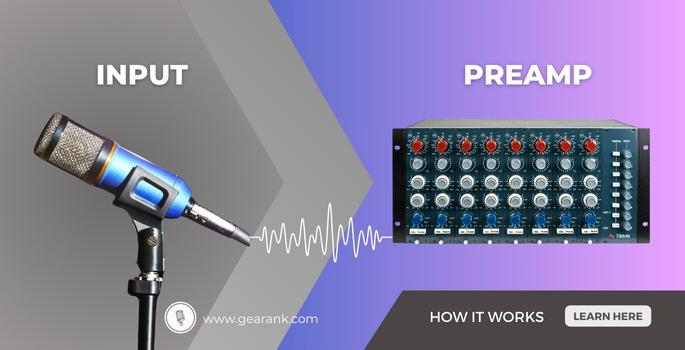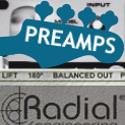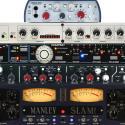What is a Preamp and Do You Need One?

What is a preamp, and what does it do? Is it important to have one?
It's easy to assume that a preamp is a device that comes before your amp. Well, that is correct, since it usually comes first in the signal chain.
However, a preamp is more than that. It's a type of amp with a unique set of characteristics and functions. In this article, I'll talk about more of those:
-
What is a Preamp?
-
How Does A Preamp Work?
-
Why Do You Need One?
-
What Are The Different Types of Preamps?
-
What is the Difference Between a Preamp and a Power Amp?
-
Tips on How To Choose The Right Preamp
In the end, you'll know what a preamp does and why you need a preamp in your signal chain.
What is a Preamp?
Signals from devices like mics, instruments, and turntables are quite weak and cannot drive speakers. But these audio signals contain enough information about your sound.
A preamp takes all those low or weak signals and optimizes them. It's then turned into a line-level signal, which works well with the line level inputs found on mixers and amplifier.
Some preamps have tone-shaping features. This can be a basic tone control like bass, mid, treble, or a full EQ setting. It also has a low-noise floor and boosts the input signal, making it more suited for more tone coloration down the signal chain.
To adjust the signal level, a preamp can also have a gain/volume control. It serves as a variable resistor, which controls the amount of output voltage passing through.
This allows you to adjust the strength of the signal, which influences how the speakers move in or out.
Note: Gain determines the amount of signal amplification, while volume refers to the loudness of the output audio signal. What a preamp does is increase the gain of the signal.
These two words are often used interchangeably. So, it is important to know the difference between them.
Inherent Noise of Tube Preamps and Solid State Preamps
All amplification circuits have inherent noise in them. In the case of a preamp, increasing the gain will also increase the noise in its signal.
A tube amp adds "harmonic distortion" to your sound. It's a type of noise that is pleasant to the ears. This is why tube amps are sought after.
On the other hand, solid-state amps add more of a white noise type of sound. Because it's random, it's usually not pleasant to the ears.
Thankfully, most modern preamps have a very low inherent noise floor, which makes this less of an issue.
How Does A Preamp Work?
The main purpose of the preamp is to boost the output signal strong enough to be used by the next component in the signal path.
But before it does that, it must first convert the audio signal into an electrical signal.
This is where the preamp's transducer goes to work. This device takes one form of energy and converts it into another.
Although amplifications tend to add noise to your signal, an audio preamp is designed to amplify your signal without adding too much noise.
This noise is sometimes so low that it's not even audible. It gives you a clean, boosted sound with little to no distortion.
Some amps use transistors for solid-state amps and produce a clean, bright, uncolored sound. Others use tubes, and produce a warmer-colored signal.
Why Do You Need One?
Having a preamp at the beginning of your audio signal chain is very important. Aside from the increase in signals, it also keeps your equipment safe.
Sending a weak mic or instrument-level signal directly to mixers or audio interfaces can cause noise or distortion that can damage your speakers and other gear. This happens when there is a mismatch in impedance (Ω) rating.
With a preamp, you can match the impedance between your devices. This allows your audio signal to flow safely.
For this reason, most audio devices have a built-in preamp and do not need a separate device.
Aside from impedance matching, tone coloration is another major reason why you need a preamp.
Preamps have their own voicings, which they apply to your sound. This is the reason why guitarists and bassists are obsessed with the tone quality of their amplifiers. This principle also applies to best budget mic preamps, headphone preamps, and more.
What Are The Different Types of Preamps?
As you can see, a preamp is a vital piece of equipment. With that being said, there are also different categories and types of preamps available for you to choose from.
Categories of Preamps
-
Clean preamps are those that take the original signal and boost it without adding too much noise or harmonic distortion. It's a great option, especially if you want to produce a transparent and accurate representation of your sound. An example of this is solid-state preamps.
-
Colored preamps, on the other hand, do the opposite. It takes the original signal and adds some sonic character to it. Tube preamps, for example, are types of colored preamps. With its thermionic valves, a rich warmth is added to the signal. This is why classic preamps with tube valves are sought-after by musicians, especially guitarists.
Types of Preamps
Microphone Preamp
A microphone preamp, AKA "mic pre," boosts the weak signals from microphones before they are sent to a mixer or recording device.
Most microphones only produce a mic-level signal, a mic preamp boosts that signal to a line level for plugging into a line input. This makes them viable for processing and recording.
Most mixers or audio interfaces have this preamp built into their circuits. But you can still integrate a separate mic preamp into your signal chain if you want to.
Mic preamps often come with phantom power support to work with a condenser mic. Condenser microphones have built-in preamp circuitry which requires power.
Modern USB condenser mics have built-in preamps that shape their tone prior to going into the USB inputs of computers.
To do this, you'll connect your microphone -> to the preamp -> then connect the preamp's output -> into a line-level input in your mixing console or audio interface, -> and then into the speakers.
Instrument Preamp
Instruments like electric guitars and keyboards usually use an instrument cable. It has a level comparable to a mic output signal. But it is a high-impedance, unbalanced signal. This means you can't plug it directly into your mic preamp or amp.
This is the reason why guitarists usually plug into guitar amps. But they can also opt for standalone preamps, or guitar processors with built-in preamp.
When plugging straight into mic preamps, some of them feature "high-z" or high-impedance inputs. The circuit inside a mixing console or amp can also feature a DI box function. Having these allows you to plug your instrument directly without the need for a separate device.
But in the absence of those two, you must use a separate device called a DI box. Place this at the beginning of your signal chain, before the mic preamp or input.
So, your signal will start from your instrument, -> into your DI box, -> to your mic preamp, -> and finally to your speakers.
Phono Preamp
The sound coming from the cartridge of your turntable is very low, so for it to be heard, you need a phono preamp. A phono preamp, AKA "phono stage," is an audio device that amplifies a signal from a turntable.
Phono preamps can be seen in different shapes and forms. A common integrated amplifier is found in newer turntables. they can also be found in vintage receivers or amplifiers.
Those that were manufactured before 1980. Also, some new high-powered speakers have them as well.
The signal chain goes as follows: right and left audio cable from your turntable -> into your phono preamp input, -> then connecting its output into your audio devices' input jack, -> then finally to the speakers.
What is the Difference Between a Preamp and a Power Amp?
A preamp, or preamplifier, is essentially a voltage amplifier that increases the low mic, instrument, or phono signal into a line-level signal. It doesn't have current or wattage, meaning it cannot drive the speakers or PA system.
This is where the power amp section comes in. In addition to the voltage amplifier for the incoming signal, power amps have a current amplifier in its output. This current amplifier is what drives the speakers to move, enabling them to produce sound.
Tips on How To Choose The Right Preamp
-
The Basics: Make sure that it can do the main job it's made for, which is to convert mic, instrument, or phone signals into line-level signals.
-
Headroom: High-end preamps tend to have more headroom than cheaper ones. This means that it will have less distortion as well.
-
Amount of Channels: Preamps can offer you multiple channels. You need to ensure that the model you buy has enough channels to be able to do everything that you need to. This is important if you want to use multiple channels at once.
-
Input and Output: Think about the input-output requirements and features your chosen preamp contains. You need to be sure you can connect your equipment to it.
Final Thoughts
A lot of people may not recognize what is a preamp. They are often hidden inside amps, mixing consoles, and turntables.
However, it's important to know that it is an essential component in audio production. Without it, audio signals from vocals or instruments will not be loud enough for the amp to process.
Having it in your signal chain ensures a loud, raw signal. It also produces a line-level signal ideal for processing by your amp.
An external preamp is always a great option. A different tool free from sharing the noise in one container, like an amp or mixer, will produce an even cleaner signal or sound.
If you have more questions about preamps, check out the FAQs section below for some answers.
Frequently Asked Questions
Can I Plug My Instrument into a Mic Preamp?
No, technically, you can't plug in an instrument cable to a mic preamp. You'll need a DI box to do that job for you.
However, most modern mixers and recording devices, like audio interfaces with mic preamps, also come with a DI box function. So, you can plug your instrument directly into those.
Ultimately, to be safe, always check the specs of your equipment to make sure you can safely plug in your instrument cable.
Can I Plug My Mic Into An Instrument Preamp?
No, microphones produce a balanced signal, so plugging them into a DI box can cause a loss of signal, noise, or distortion.
Instrument preamps like DI boxes converts unbalanced, high-impedance signals from an instrument.
Is an Amplifier Still Needed If I Have a Separate Preamp?
Yes, you still need an amplifier, even if you have a preamp. Preamps need a power amplifier circuit to drive your speakers. Note that most instrument amplifiers come with both preamp and poweramp built-in.
The current from a power amplifier is needed to push the speakers and produce sound.
Contributors:
- Jerome Arcon - Co-writer
- Jerry Borillo - Illustrator












